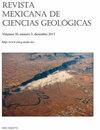加利福尼亚湾巴拉纳斯运河变换断层边缘的更新世火山活动
IF 0.5
4区 地球科学
Q4 GEOSCIENCES, MULTIDISCIPLINARY
Revista Mexicana De Ciencias Geologicas
Pub Date : 2022-03-30
DOI:10.22201/cgeo.20072902e.2022.1.1659
引用次数: 0
摘要
加利福尼亚湾北部巴伦纳斯海峡边缘的更新世陆基火山活动,以暴露在剪切大陆地壳相对边缘的两个形态年轻的英安岩穹状杂岩为代表:位于下加利福尼亚州沿海的科罗纳多岛和位于Ángel de la Guarda岛中西部的洛贝拉火山杂岩。Coronado火山和Lobera火山的单晶锆石U-Pb结晶年龄在250 ~ 1000 ka之间,表明喷发的最大年龄。Lobera火山杂岩中一个熔岩单元的40Ar/39Ar全岩年龄(692±164 ka)直接制约了喷发年龄。更新世锆石微量元素显示出大陆亲和性,这支持了不同混合和AFC情景模拟的放射性成因(Nd, Sr)同位素数据,表明morb型原生岩浆具有明显的(~10 - 20%)地壳同化作用,涉及东半岛山脉基岩的调性基底。本文章由计算机程序翻译,如有差异,请以英文原文为准。
Pleistocene volcanism along the margins of the Canal de Ballenas transform fault, Gulf of California
Pleistocene subaerial volcanism along the margins of the Ballenas Channel, northern Gulf of California, is represented by two morphologically young dacite dome complexes exposed at the opposite edges of sheared continental crust: Isla Coronado in coastal Baja California, and the Lobera volcanic complex in west-central Isla Ángel de la Guarda. Single crystal zircon U-Pb crystallization ages of Coronado and Lobera volcanoes range between ca. 250 and 1000 ka, indicating maximum ages for the eruptions. Eruption ages are directly constrained by an 40Ar/39Ar whole-rock age of 692 ± 164 ka for one of the lava units in the Lobera volcanic complex. Trace elements in Pleistocene zircon indicate continental affinity, which supports radiogenic (Nd, Sr) isotopic data that were modeled using different mixing and AFC scenarios indicating a MORB-type primary magma with significant (~10–20 %) crustal assimilation involving tonalitic basement of the eastern Peninsular Ranges Batholith.
求助全文
通过发布文献求助,成功后即可免费获取论文全文。
去求助
来源期刊

Revista Mexicana De Ciencias Geologicas
地学-地球科学综合
CiteScore
1.00
自引率
12.50%
发文量
0
审稿时长
6-12 weeks
期刊介绍:
Revista Mexicana de Ciencias Geológicas (RMCG) publishes original research papers on geological processes of broad interest, and particularly those dealing with regions of Latin America. The RMCG also publishes review papers on topics of current interest, and on the geology and tectonics of geological provinces of Latin America. Besides, it offers the opportunity for host editors to publish special thematic issues.
 求助内容:
求助内容: 应助结果提醒方式:
应助结果提醒方式:


